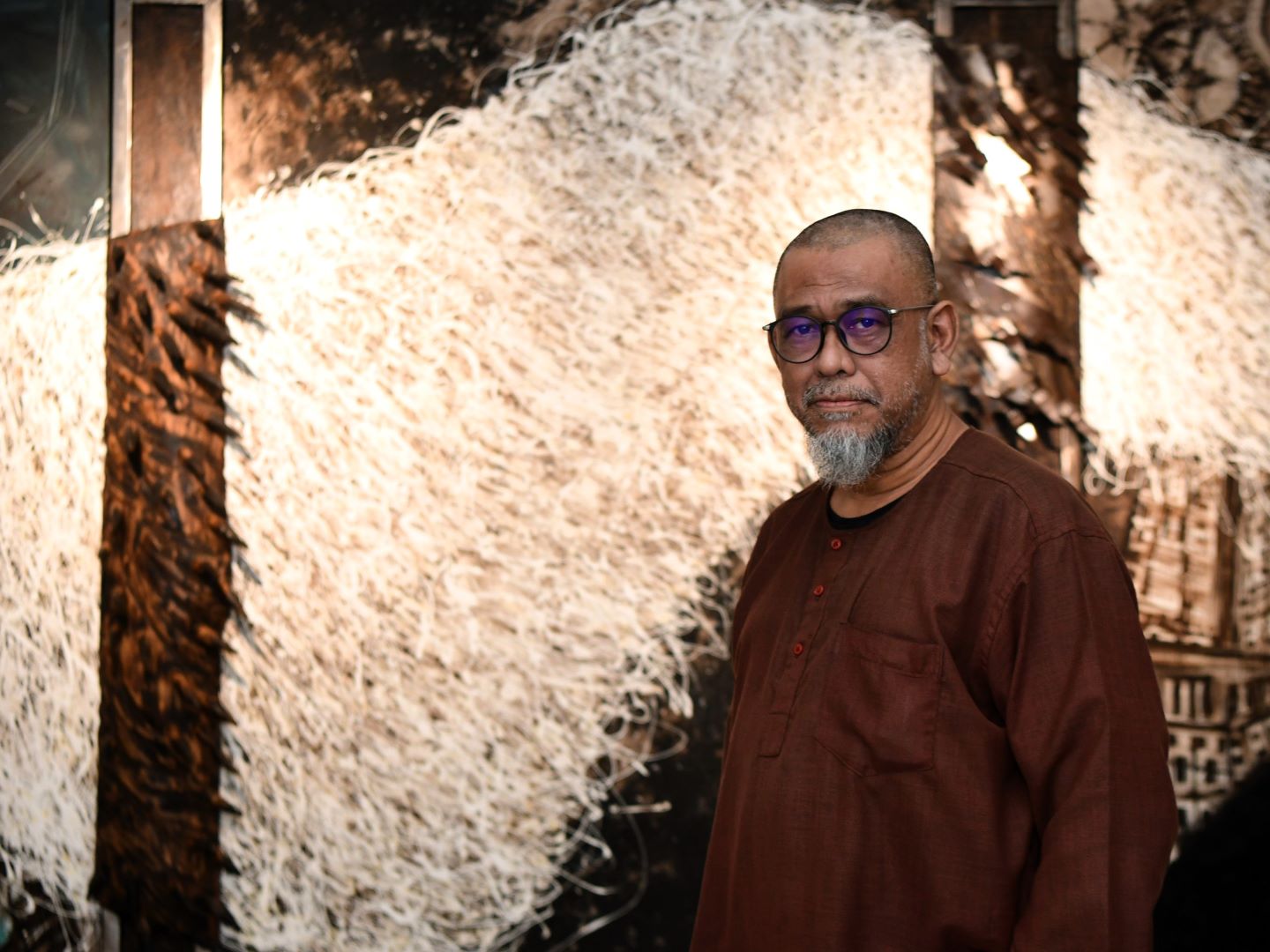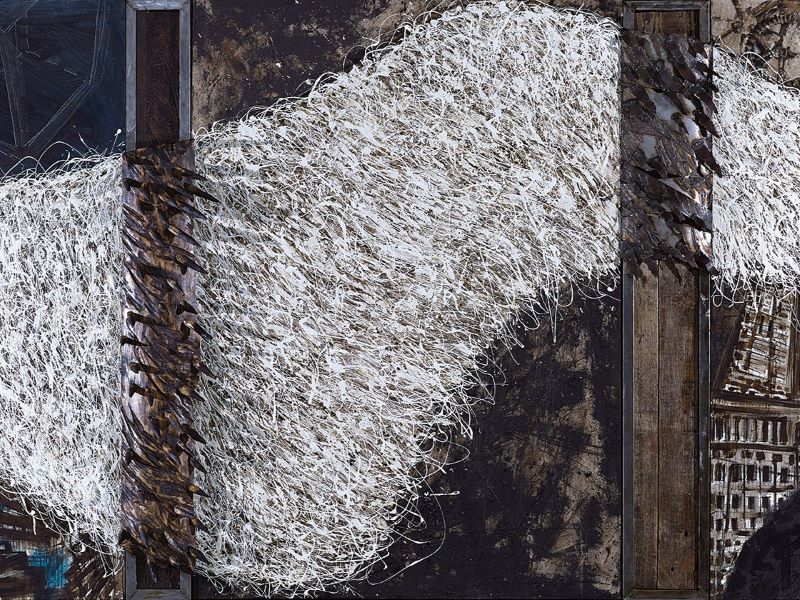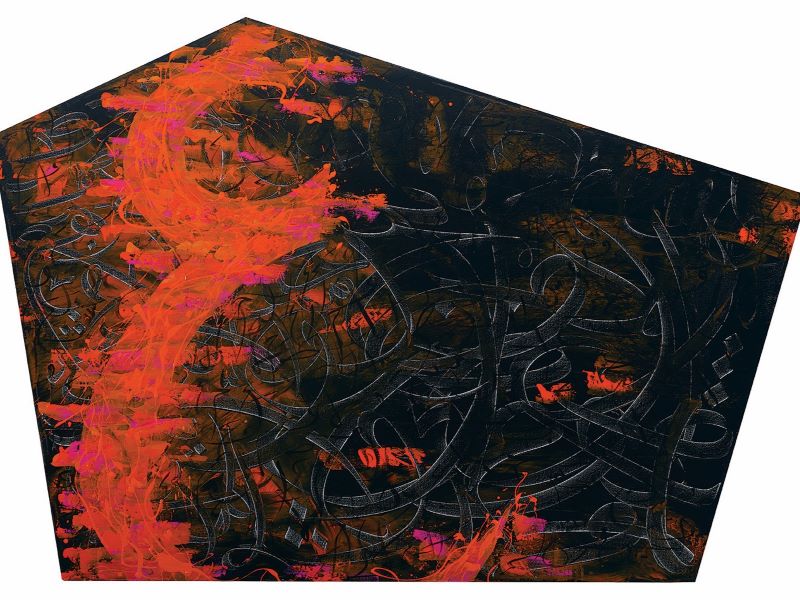
Husin’s art combines powerful abstract expressionism with Jawi calligraphy (All photos: Patrick Goh/The Edge)
In light of the diminishing proficiency in writing and reading Jawi script among Malay youths, contemporary artist Husin Hourmain has embarked on a crucial mission to safeguard this cultural heritage with his unique approach.
We meet at Harta Space, where he is holding his 10 Years’ Journey in the Art of Islamic Calligraphy in collaboration with Core Design Gallery. The exhibition is a retrospective of sorts, as Husin takes Options through the collection of 18 pieces starting from the 2013 Awal Hurouf Asal Hurouf show that catapulted his name into the landscape of Islamic calligraphy in Malaysia. His khat calligraphy-meets-abstract expressionism works are a breath of fresh air and the scale is unprecedented.
“Yes, it was an eye-opener for the younger generation to look into this dying art. My reference at that time was only senior artist Ahmad Khalid, but his works were smaller, dominated by landscapes with ‘polite’ use of Jawi alphabet. In comparison, my body of work carries strong strokes but I still maintain the discipline of respecting the alphabet,” he explains.
Art becomes meaningful when the artist uses it to explore a higher purpose, and Husin achieved precisely that with his seminal exhibition Aku: Dalam Mencari Rukun... in 2018 at the National Art Gallery, Kuala Lumpur. This exhibition can be seen as a spiritual journey rooted in the six pillars of faith, encompassing belief in Allah, the angels, the holy Quran, prophets, the Day of Judgment and fate. His personal interpretation of each pillar is reflected through abstract expressionism, iconography and calligraphy within the exhibition.
one_of_husins_largest_works_penunggu_alam_sayap_jibril_on_canvas_and_iron_wood_panels_measuring_214cm_x_412cm_from_his_2018_aku_dalam_mencari_rukun._exhibition.jpg

“Here in my Salam @ Peace show in 2021, you can see how the mixed-media paintings, each featuring single letters painted in a variety of bright hues, represent a time of reflection and staying positive,” he says. “I found myself going back to my Awal Hurouf Asal Hurouf exhibition, which was a turning point in my life.” Besides experimenting with pops of colour, he also worked on unusual canvas sizes beyond the standard square or rectangle.
We conclude our tour with his 2022 show Vertical Limit: Endless Journey, for which Husin skillfully juxtaposes Jawi script with Latin. Through a deliberate choice of a dominant black colour palette, he masterfully conveys intricate social and personal narratives that are deeply rooted in his experiences and reflections stemming from his umrah pilgrimage in February 2023.
When observing artists who engage in spiritual themes, particularly in places like Thailand, where motifs such as lotus flowers and Buddha statues are commonplace, the imagery tends to be quite literal. However, in Islam, the reproduction of images is prohibited and this restriction has deeply influenced his approach to artistic expression.
Husin adheres to religious guidelines in crafting his art by meticulously exploring various concepts and ideas. He begins by recording his thoughts and inspirations in a sketchbook (he has hundreds of them, which he proudly acknowledges). This process allows him to refine his ideas over time, ensuring that they align with the principles and teachings of Islam. He conducts thorough research, consulting with scholars to understand the dos and don’ts within the framework of Islamic art.
finding_light_in_ain_painted_on_an_unconventional_canvas_in_his_salam_peace_show.jpg

His journey in navigating these commandments is guided by wisdom. He remembers the advice of a scholar who emphasised that, ultimately, he is “producing art and not an Islamic book”. This perspective only encouraged him to view his creations as personal interpretations of his faith, akin to composing music or writing a novel inspired by specific themes or historical periods.
While Husin serves as a conduit for his faith, he clarifies that his artwork is not inherently religious. “It contains no verses from the holy Quran, unless it is a special commission. I do have non-Malay collectors,” he says. His body of work comprises renditions of the Jawi alphabet, which are deeply entrenched in the history and cultural fabric of the Malay world. The waning usage of Jawi among the younger generation signifies not only a decline in linguistic proficiency but also a detachment from cultural heritage.
Through his artistic endeavours, Husin hopes to reignite interest in this script, bridging this growing gap and cultivating a renewed appreciation for the script’s beauty and historical significance.
Furthermore, his work carries a poignant message: the importance of preserving a dying art that risks fading away in a few decades if not safeguarded. It resonates universally, transcending cultures and appealing to anyone invested in preserving heritage and cultural legacies.
'The 10 Years’ Journey in the Art of Islamic Calligraphy' show at Harta Space, Level 1, Lot 93-95, Lorong Mamanda 2, Ampang, Selangor, runs until April 6. Check out hartaspace.com for details.
This article first appeared on Mar 18, 2024 in The Edge Malaysia.


